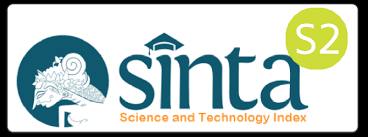Profiling Self-regulated Learning in Online Mathematics Teacher Training: A Case Study of a GeoGebra Course
Abstract
Online training has now become an alternative means of delivering continuous
professional development courses to improve teacher competencies. The benefits of online training are flexibility of access, cost efficiencies, ease of content updates, and uniformity of content. However, there are many aspects that determine if teachers can be successful in online training, and one is self-regulated learning. This study aims to profile self-regulated learning as case study in an online mathematics teacher training held by PPPPTK Matematika using GeoGebra. Using a survey method, this study describes the participants’ self-regulated learning profile as they accomplished nine tasks in the GeoGebra course.
Keywords
Full Text:
PDFReferences
Badan Pusat Statistik. (2016). Retrieved from https://www.bps.go.id/Subjek/view/id/28#subjekViewTab3|accordion-daftar-subjek1
Burns, M. (2011). Distance education for teacher training: modes, models, and methods. Wasihington DC: Education Development Center, Inc.
Chen, C. S. (2002). Self-regulated learning strategies and achievement in an introduction to information systems course. Information Technology, Learning, and Performance Journal, 20(1), 11-25.
Cheung, A. C., & Slavin, R. E. (2013). The effectiveness of educational technology applications for enhancing mathematics achievement in k-12 classrooms: A metaanalysis. Educational Research Review, 9, 88-113.
Delfino, M., Dettori, G., &Persico, D. (2011). Influence of task nature on learner selfregulation in online activities. In G. Dettori, & D. Persico, Fostering self-regulated learning through ICT (pp. 145-161). New York: IGI-Global.
Eisinger (2000) A Framework for e-learning as a tool for knowledge management. Industrial Management and Data System, 102, 371-380.
El-Seoud, M. S., Taj-Eddin, I. A., Seddiek, N., El-Khouly, M. M., & Nosseir, A. (2014). Elearning and students’ motivation: A research study on the effect of e-learning on higher education. International Journal of Emerging Technologies in Learning (iJET), 20-26.
Harris , B. R., Lindner, W. R., & Pina, A. A. (2011). Strategies to promote self-regulated learning in online environments. In G. Dettori, & D. Persico, Fostering self-regulated learning through ICT (pp. 121-144). New York: IGI-Global.
Perraton, H. (2002). Distance education for teacher training. New York: Taylor and Francis Group.
Zimmerman, B. J. (1990). Self-regulated learning and academic achievement: An overview. Educational Psychologist, 25(1), 3-17.
Zimmerman, B. J. (2002). Becoming a self-regulated learner: An overview. Theory into Practice, 41(2), 64-70.
Zumbrunn, S., Tadlock, J., & Roberts, E. D. (2011). Encouraging self-regulated learning in the classroom: A review of the literature. Metropolitan Educational Research Consortium (MERC). VA: Virginia Commonwealth University.
DOI: https://doi.org/10.46517/seamej.v7i1.44
Refbacks
- There are currently no refbacks.
Indexed by:
Southeast Asian Mathematics Education Journal
SEAMEO Regional Centre for QITEP in Mathematics
Jl. Kaliurang Km 6, Sambisari, Condongcatur, Depok, Sleman
Yogyakarta, Indonesia
Telp. +62 274 889955
Email: seamej@qitepinmath.org
p-ISSN: 2089-4716 | e-ISSN: 2721-8546
Southeast Asian Mathematics Education Journal is licensed under a Creative Commons Attribution 4.0 International License
View My Stats
Supported by:



